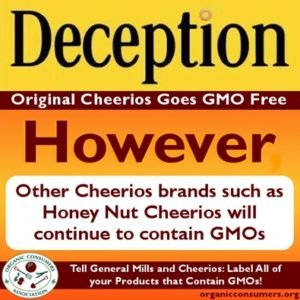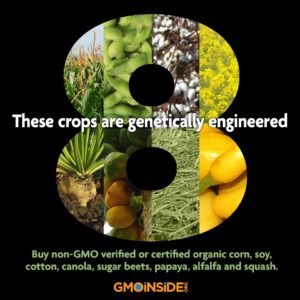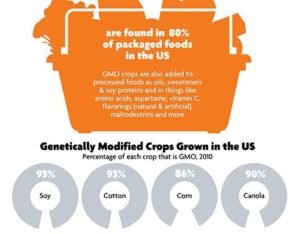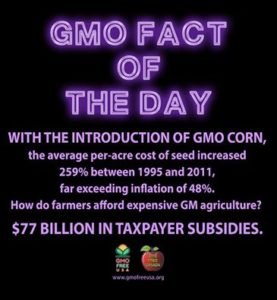by Susan Dean | Feb 2, 2018 | Food and Health Dangers, Gardening, Health
More and more foods and products are being genetically engineered or contain genetically engineered ingredients. Here are eight of the most common to look out for. If a product contains these ingredients and is not labeled non-GMO Verified or Organic Certified, there’s a good chance it contains GMOs:
Alfalfa
Canola
Corn
Cotton
Papaya
Soy
Sugar Beets
Zucchini and Yellow Summer Squash
ALSO high-risk: animal products (milk, meat, eggs, honey, etc.) because of contamination in feed.
What product ingredients commonly contain genetically engineered crops?
Amino Acids, Aspartame, Ascorbic Acid, Sodium Ascorbate, Vitamin C, Citric Acid, Sodium Citrate, Ethanol, Flavorings (“natural” and “artificial”), High-Fructose Corn Syrup, Hydrolyzed Vegetable Protein, Lactic Acid, Maltodextrins, Molasses, Monosodium Glutamate, Sucrose, Textured Vegetable Protein (TVP), Xanthan Gum, Vitamins, Yeast Products. Read more »
Why should we be concerned about GMOs?
Human Health Risks: More and more studies point to the idea that there’s grave cause for concern about the health effects of consuming GMOs and the chemicals they are sprayed with, including food allergies, irritable bowels, organ damage, and cancer.
Environmental Risks: Seventy-two percent of US GMO crops are engineered to tolerate a certain type of herbicide. But the weeds that these herbicides used to kill are coming back bigger and stronger, creating herbicide-resistant “superweeds” that require greater quantities of more toxic pesticides to eradicate.
The Risk To Farmers In Developing Countries: Every thirty minutes, a farmer commits suicide in India due to meet rising debts, a phenomenon that has been steadily rising since the 1970s. While the causes behind the farmers’ crushing debt and resultant suicides are complex—ranging from unfair government floor prices for cotton to international trade agreements skewed in favor of other countries—GM seeds do appear to play a role.
The Risk to Organic Farmers: Even when a farmer isn’t growing GM crops, contamination can easily occur—through seed mixing or pollen drift from neighboring GM fields. While this contamination is troubling for those of us who wish to avoid GMOs, it can be an economic disaster for organic and family farmers.
How can we avoid GMOs?
There are several choices you can make when buying groceries and eating out to try and avoid GMOS.
Look for the Non-GMO Project label.
Buy organic certified produce and packaged foods.
Avoid high-risk ingredients.
Be wary of non-GMO claims that lack certification.
Avoid processed foods.
Watch out for restaurants.
Buy and plant your own organic seeds.












by Susan Dean | Feb 2, 2018 | Food and Health Dangers, Gardening, Health

Genetically Modified Organisms
The United States government has allowed genetically modified and engineered organisms to enter the public food supply with no warning. Every day, millions of people unknowingly ingest these GMOs because corporations like Monsanto (and the politicians they’ve bought and paid for) claim it’s unfair to require them to label their products.
Multiple scientific studies have linked GMOs to illness, disease, and mutations in plants, animals, and humans. Adverse affects are especially pronounced in pregnant women and children. The low price, processed foods carry most of the world’s GMOs. The only way to protect yourself from these toxic “foods” is to avoid buying and eating them.
These are the foods that are worth the extra time it may take to research origins and the extra money it may cost to buy organic. Buying local is ideal, because you can contact the farmer directly to ask what kinds of seeds are used.
- Tomatoeswere the first genetically modified crop to be commercially available in the U.S. In 1994, transgenic tomatoes known as FlavrSavrshit the market. They contained a “deactivated” gene that was supposed to prevent the fruit from getting soft as it ripened. It didn’t work as well as biotech companies hoped. Now, experts are praising a new technique whereby two enzymes, (A-Man, B-hex) are suppressed. There have been reports that some animals have died shortly after consuming GMO tomatoes.
- CornThis one is tough, because even foods that you wouldn’t normally associate with corn have ingredients, like sweeteners, that are derived from GMO corn. As Care2′s Jaelithe Judy reports, genetically modified cornand soybeans were developed by Monsanto in the 1990s to be resistant to the synthetic herbicide glyphosate (better known by Monsanto’s trademarked name for the weedkiller, Roundup). Now, more than 70 percent of corn produced in the United States is the genetically modified, herbicide-resistant variety. Fresh corn from Walmart should be especially avoided.
- PapayasIn the late 1980′s biotech researchers developed a papaya cultivar that would be resistant to Papaya Ringspot Virus. To do this, certain viral genes encoding capsid proteins were transferred to the papaya genome. Now, GMO papayas make up about 75 percent of the total Hawaiian papaya crop.
- Riceis considered to be one of the world’s staple crops. In many areas, it has been genetically modified to contain a high amount of vitamin A. More recently, it was discovered that an American company, Ventria Bioscience, has been cultivating rice that’s genetically modified (GM) with genes from the human liver. Although the company claims it’s only producing this rice to help speed pharmacuetical research, it’s growing it in open, outdoor fields. Meaning crops nearby can be unknowingly contaminated. China, which grows and consumes a huge percentage of the global rice supply, recently suspended distribution of genetically modified rice within its commercial food supplies over growing concern about its safety.
- Potatoeswere once one of the world’s most important staple crops, but thanks to growing awareness about the harm of too many empty carbohydrates, demand for potatoes as food has waned slightly in the past few years. Desperate for a way to infuse potatoes with more nutrients, researchers in India created a potato with thirty-five to sixty percent more protein using genes from the amaranth seeds. The potato is still very valuable to the starch and chemical industry, however. In order to protect these starch crops from pets and disease, potatoes are sometimes genetically modifiedwith Bacillus thuringiensis var. Kurstaki Cry 1. Yet, mice fed GE potatoes have shown abnormal amounts of toxins in their systems. According to Dr. Nina V. Fedoroff Willaman, Professor of Life Sciences and Evan Pugh Professor at Pennsylvania State University found that “rats fed the transgenic potatoes had significantly lower organ weights.”

Research links Monsanto’s GMO corn to cancer, tumors and an increase risk of premature death in both men and women. News of the research is spreading like wildfire across the ‘net, and support for Proposition 37 — which seeks to label GMOs in foods — is growing by the day.
According to the Center for Food Safety, up to 85% of the corn grown in the United States is genetically modified. This means corn-based cereals that use non-organic corn have a very high likelihood of containing GM corn.
The following list presents the top 10 popular breakfast cereals most likely to contain Monsanto’s genetically modified corn. The exact GMO content of these cereals remains a mystery precisely because manufacturers of these cereals refuse to label them with their GMO content.
Legal note: This article is presented in the public interest, reflecting reasonable caution over a common food ingredient which French scientists have now convincingly linked to cancer and premature death in studies conducted on rats.
The top 10 popular breakfast cereals most likely to contain Monsanto’s GM corn
http://www.naturalnews.com/037315_Monsanto_GM_corn_breakfast_cereals.html#ixzz2Og4iFL7N
Which cereals contain no GMOs? Nature’s Path
There is only one brand of breakfast cereal I know of that’s 100% non-GMO and 100% organic across their entire product line. That company is Nature’s Path:
Many “natural” brands that appear to be healthful and natural are actually not organic or GMO-free. For example, “Barbara’s Bakery” cereals are not organic. Although they are positioned in store shelves alongside other organic cereals, they are actually made with conventional crops grown with pesticides that may include Monsanto’s Roundup.
You may notice that most of the cereal likely to contain GM corn are children’s cereals. It is the children in America who are being fed the most GMOs. This represents a highly unethical food experiment being conducted on an entire generation, and the long-term effects of human consumption of GMOs are simply not known. What we do know is that rats fed this very same Monsanto GM corn developed shockingly large cancer tumors.
The photo released by the French research team, showing large cancer tumors growing at a strongly heightened risk in rats fed a “lifetime” of Monsanto’s GM corn, is shown below. According to that study, 70% of females died premature and showed significant damage to their liver, kidneys and other organs.

Top 10 Worst GMO Foods
1. Corn: As many as half of all U.S. farms growing corn for Monsanto are using genetically modified corn,” and much of it is intended for human consumption. Monsanto’s GMO corn has been tied to health issues that include weight gain and organ disruption.
2. Soy: Found in tofu, vegetarian products, soybean oil, soy flour, and numerous other products, soy is modified to resist herbicides. As of now Monsanto still has a tight grasp on the soybean market, with approximately 90 percent of soy being genetically engineered to resist Monsanto’s herbicide Roundup. In one single year, 96.7 million pounds of glyphosate was sprayed on soybeans alone
3. Sugar: According to NaturalNews, genetically modified sugar beets were introduced to the U.S. market in 2009. Like others, they’ve been modified by Monsanto to resist herbicides.
4. Aspartame: Aspartame is a toxic additive used in numerous food products, and should be avoided for numerous reasons, including the fact that it is created with genetically modified bacteria.
5. Papayas: GMO papayas have been grown in Hawaii for consumption since 1999. Though they can’t be sold to countries in the European Union, they are welcome with open arms in the U.S. and Canada.
6. Canola: One of the most chemically altered foods in the U.S. diet, canola oil is obtained from rapeseed through a series of chemical actions.
7. Cotton: Found in cotton oil, cotton originating in India and China in particular has serious risks.
8. Dairy: Your dairy products contain growth hormones, with as many as one-fifth of all dairy cows in America are pumped with these hormones. In fact, Monasnto’s health-hazardous rBGH has been banned in 27 countries, but is still in most US cows. If you must drink milk, buy organic.
9. and 10. Zucchini and Yellow Squash: Closely related, these two squash varieties are modified to resist viruses.
The dangers of some of these foods are well known. The Bt toxin being used in GMO corn was recently detected in the blood of pregnant women and their babies. All the risks that are still unknown.


by Susan Dean | Feb 2, 2018 | Gardening
Using pallets for building and growing
You can’t build outside with untreated pallets. These treated pallets are lined so that there would be no contact between the plants and the treated pallet wood.
You can build a worm bin using them too.





















by Susan Dean | Feb 1, 2018 | Gardening

Turk’s Cap A Deciduous Perennial Shrub
Malvaviscus arboreus Malvaviscus is from a Greek word meaning “sticky mallow”.
mal-vah-VISS-kus ar-BOR-ee-us
Turk’s cap was designated a 2011 Texas Superstar because when it comes to climate and soils, it is a very tough versatile plant. It is native to South Texas, and is a magnet for butterflies and hummingbirds. It is a very versatile plant and easy to propagate. It’ll grow in full sun, full shade, wet soil, dry soil, alkaline soil and acid soil. The plants are perennial in Zones 7 to 11. The plant becomes progressively more “shrub-like” the further south one goes. It’s an old garden plant that’s found at old-home sites and in old gardens. Gardeners passed along clippings to relatives and friends down through several generations.
Turk’s cap has dark green leaves and cherry-red or white flowers that look like miniature Turkish turbans. Turk’s cap leaves may become lighter green and take on a more quilted appearance in very sunny locations. It can be grown easily from seed.
Its name is derived from the shape of the small blooms it produces continuously from early summer through late fall. A pistil protrudes above the petals that are loosely rolled to somewhat resemble a delicate rosebud. The dark green heart-shaped leaves of this hibiscus family member are large and provide an interesting contrast to the brilliantly colored flower. Its vermillion red flowers are twisted into a tube showing extended red stamens protruding from the whorl.
You can harvest the flowers, fruit, and young leaves. It has red fruit resembling rose hips in the late summer. The marble-size red fruit is edible, having a mealy taste, and is enjoyed by a number of birds and animals. Eat flowers and young leaves raw or cooked; flowers can make pink lemonade type drink; fruit can be made into tea or preserves. The flowers and fruit make a good herb tea. The fruit is edible either raw or cooked, tasting rather like apple, hence its Spanish name, Manzanilla (Little Apple). The fruit is full of pulp and seed; cooked down, it produces a good jelly or syrup. The flavor of the raw fruit resembles that of watermelon or apple.
Nutritional Value: Flowers high in antioxidants; seeds are high in protein & starch; leaves high in minerals; fruit high in vitamin C
Its leaves have been used as an emmolient and in Mexico the flowers are used in a decoction to treat inflammation of the digestive tract and as a menstrual aid.
A well-established Turk’s Cap is difficult to dig up due to its very tough, dense and deep roots.
by Susan Dean | Feb 1, 2018 | Gardening

Packed with nutrients and cancer-fighting compounds, blueberries are tasty and so easy to grow. Blue Crop blueberries take frigid winters and produce huge crops in July. The healthiest and one of the tastiest fruits, the blueberry, is simple to grow. Chandler is the biggest berry you can grow. Most are as big as a nickel.
You amend the soil, plant the bush, mulch and water. That’s it! No spraying, no endless pruning or other maintenance. Most are self-pollinating, although two different varieties will insure heavy fruit set. In return you get gorgeous bell-like flowers in the spring, tasty fruit and vivid fall foliage in tones of red, rust and orange that accent your landscape.
Blueberry bushes require soil with low pH (about 4.5 to 5.5) that is porous; you don’t have to replace your alkaline or clay soil. Just amend the planting area. Stake out a 3 by 9-foot bed for four bushes. Add a bale of peat and a cup of soil sulfur to alkaline soil. Blueberries have shallow roots and they love moisture. The peat plus the soil sulfur will bring down the pH of the bed from 7.3 to 5.2. Adding soil sulfur every spring keeps the pH in the desirable range. Test the pH before adding sulfur to see if it’s needed.
Thick mulch is a must. It insures the roots stay healthy. Use pine needles and top them off with six inches of straw. Very little pruning is needed, but it should be done in early spring while plants are dormant.
The first two years, the bush’s structure is formed, so specific cuts must be made to spur growth and form fruit buds. After that, spring pruning is a matter of removing dead canes and cleaning up any problems.
Disease problems are non-existent. Nothing seems to bother plants, except birds pecking the berries as they ripen. Bird netting, a pet cat or dog in the yard or situating bushes near a house entrance takes care of birds.
Blue Crop, Chandler, Patriot and Pink Lemonade bushes are all high-bush blueberries that thrive in cold-winter climates. Rabbit-eye varieties do best in the southern states.














































